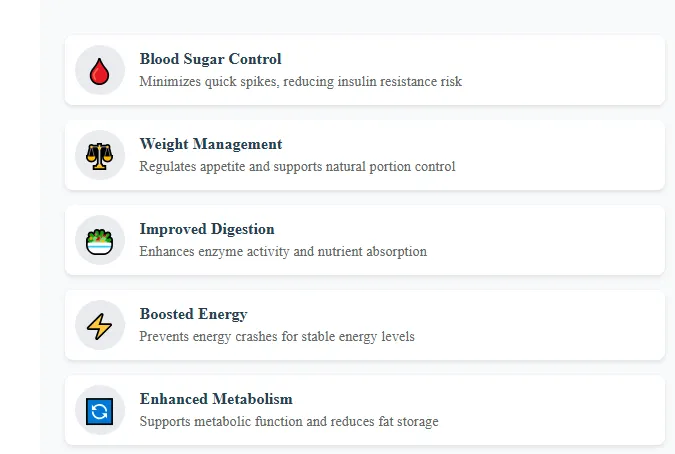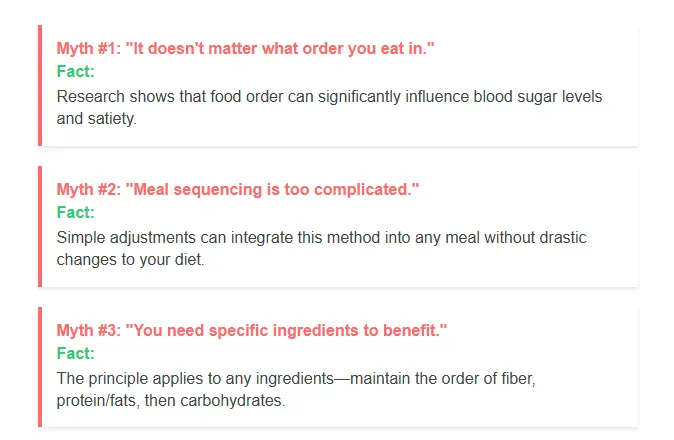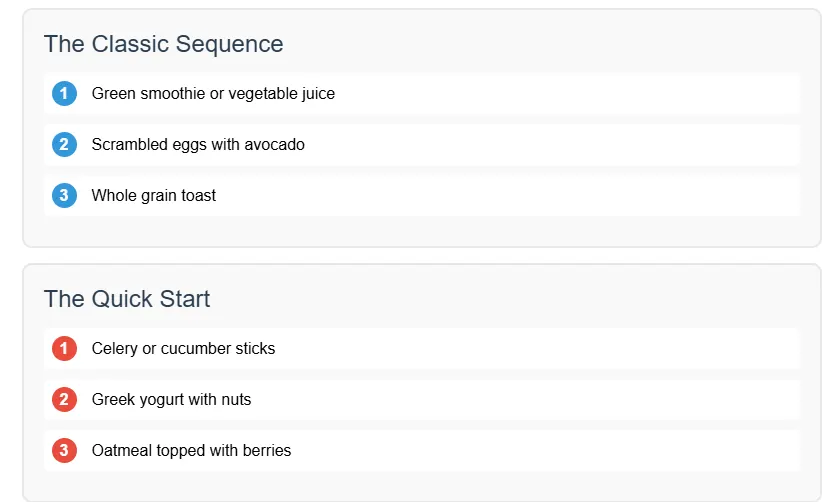The Ultimate Guide to Meal Sequencing: Transform Your Health by Changing How You Eat (Not Just What You Eat)
Have you ever wondered if the order in which you eat your food matters? While we often focus on what to eat, emerging science suggests that when and how we eat our food could be just as important. Welcome to the world of meal sequencing – a simple yet powerful approach that could revolutionize your relationship with food and dramatically improve your health.
Table of Contents:
- Table of Contents
- Understanding Meal Sequencing
- The Science Behind Food Order
- Benefits of Strategic Meal Sequencing
- How to Sequence Your Meals
- Practical Meal Examples
- Common Myths and Misconceptions
- Tips for Success
- Special Considerations
- Real-Life Success Stories
- Troubleshooting Guide
- Conclusion
Understanding Meal Sequencing
Meal sequencing is a scientifically backed approach to eating that focuses on the order in which you consume food rather than simply what you eat. The concept is simple:
- Start with fiber-rich vegetables: They help prepare your digestive system.
- Then eat proteins and healthy fats: These slow down gastric emptying and trigger satiety hormones.
- Finish with complex carbohydrates: Eating these last minimizes rapid blood sugar spikes.
By following this specific order, you optimize digestion and reduce the risk of blood sugar spikes, leading to stable energy levels, reduced cravings, and better overall metabolic health.
The Science Behind Food Order
Meal sequencing takes advantage of the body’s natural digestive processes. Here’s a breakdown of the science:
Phase 1: Fiber First
- Role of Vegetables:
- Eating fiber-rich vegetables at the beginning of your meal boosts the production of digestive enzymes and forms a protective gel-like layer. This gel slows down the absorption of sugar and prepares your stomach for the heavier components to come.
Phase 2: Protein and Fats
- Impact on Satiety and Digestion:
- Consuming proteins and healthy fats after vegetables causes slower gastric emptying. This not only helps you feel fuller longer but also triggers the release of hormones like cholecystokinin (CCK) and glucagon-like peptide-1 (GLP-1), which enhance nutrient absorption and stabilize blood sugar.
Phase 3: Carbohydrates Last
- Controlling Blood Sugar Spikes:
- When carbohydrates are eaten after the fiber and protein layers, they’re absorbed more slowly. The result is a smaller, more gradual increase in blood sugar, reducing energy crashes and curbing hunger.
Hormonal Impact
- GLP-1 and Insulin:
- Increased GLP-1 boosts insulin sensitivity and reduces appetite, while a more moderated insulin response leads to less fat storage.
- CCK Benefits:
- CCK not only promotes feelings of fullness but also aids in reducing overall food intake and improves digestion.
Benefits of Strategic Meal Sequencing
Adopting a meal sequencing approach provides a multitude of health advantages:
- Blood Sugar Control:
- Minimizes quick spikes, reducing the risk of insulin resistance.
- Weight Management:
- Helps regulate appetite and supports natural portion control.
- Improved Digestion:
- Enhances enzyme activity, reduces bloating, and improves nutrient absorption.
- Boosted Energy and Mood:
- Prevents energy crashes, leading to stable energy levels and a better mood.
- Enhanced Metabolic Health:
- Supports overall metabolic function, reduces fat storage, and can even promote a healthier gut microbiome.

How to Sequence Your Meals
Implementing meal sequencing into your daily routine is easy. Follow these steps:
- Start with Vegetables:
- Spend 5–10 minutes consuming a serving of fresh, steamed, or lightly sautéed vegetables or a smoothie made with leafy greens.
- Next, Eat Proteins and Healthy Fats:
- Allow another 10 minutes to have a source of protein (like eggs, lean meats, tofu) paired with healthy fats (such as avocado, olive oil, or nuts).
- Finish with Complex Carbohydrates:
- Consume your carbohydrate portion (whole grains, starchy vegetables) in the final 10 minutes. This ensures your digestive system is primed to absorb carbs slowly.
- Overall Timing:
- Aim for a total meal duration of about 25–30 minutes to maximize the benefits.
Practical Meal Examples
Below are some actionable meal sequences to get you started:
Breakfast Options
- The Classic Sequence:Begin with a green smoothie or a vegetable juice.
- Follow up with scrambled eggs with avocado.
- End with a slice of whole grain toast.
- The Quick Start:Start with a few celery or cucumber sticks.
- Enjoy a bowl of Greek yogurt sprinkled with nuts.
- Finish with a serving of oatmeal topped with berries.
Lunch Ideas
- Office-Friendly Sequence:Begin with a mixed green salad.
- Enjoy a lean protein source like tuna or grilled chicken.
- End with a side of quinoa or brown rice.
- On-the-Go Option:Snack first on pre-cut vegetables.
- Eat a protein-rich item like a hard-boiled egg with almonds.
- Wrap it up with a whole grain wrap filled with veggies.
Dinner Suggestions
- Family-Style Sequence:Start with a hearty vegetable soup or roasted seasonal vegetables.
- Serve a protein like baked fish or a lean steak.
- Conclude with a complex carbohydrate such as sweet potato or whole grain pasta.
- Vegetarian Option:Kick off with steamed broccoli and carrots.
- Follow with a protein-rich lentil or tofu dish.
- End with brown rice or whole grain couscous.
Common Myths and Misconceptions

Despite its growing popularity, there are some common myths about meal sequencing:
- Myth 1: "It doesn’t matter what order you eat in."
- Fact: Research shows that food order can significantly influence blood sugar levels and satiety.
- Myth 2: "Meal sequencing is too complicated for everyday life."
- Fact: With simple adjustments, you can integrate this method into any meal without drastic changes to your diet.
- Myth 3: "You need specific ingredients to benefit."
- Fact: The principle applies regardless of the ingredients—as long as you maintain the order of fiber, protein/fats, and carbohydrates, you can reap the benefits.
Tips for Success
Implementing meal sequencing can be even easier with a few tips:
- Start Gradually:
- Implement the sequence in one meal daily until you’re comfortable.
- Meal Prep:
- Pre-cut vegetables and prepare protein portions ahead of time for busy days.
- Track Your Results:
- Keep a food journal noting your meals, energy levels, and hunger cues.
- Be Flexible:
- In social situations or at restaurants, do your best to maintain the order even if you have to adapt it.
- Stay Consistent:
- Consistency is key; even small positive changes can lead to significant health improvements over time.
Special Considerations
While meal sequencing is generally beneficial, certain groups should tailor the approach to their needs:
- For Diabetics:
- Monitor blood sugar responses carefully and adjust medication timing accordingly. Consult with your healthcare provider and document your responses.
- For Athletes:
- Balance your training nutrition by adjusting portions and timing, especially around pre- or post-workout meals.
- For Busy Professionals:
- Use meal-prep strategies and invest in portable, healthy snacks that fit the sequencing approach. Consider keeping meals simple on the go.
Real-Life Success Stories
Susan’s Journey to Steady Energy:
After struggling with afternoon crashes and constant hunger, Susan began rearranging her meals. By starting with fiber-rich salads, followed by her protein sources, and ending with a slow-digesting carbohydrate, she experienced sustained energy throughout the day and even noticed improvements in her weight management.
Mark’s Improved Glycemic Control:
Mark, a 45-year-old with prediabetic tendencies, started applying meal sequencing during every meal. Over a few months, his blood sugar spikes diminished, and he felt fuller for longer. Working closely with his nutritionist, Mark has now integrated these practices into his daily routine and reports overall better metabolic health.
Troubleshooting Guide
Even with these strategies, you might face some hurdles. Here’s how to troubleshoot common challenges:
- Time Constraints:
- • Prep vegetables and proteins in advance.
- • Use batch cooking to prepare components for several meals at once.
- Social Situations:
- • Choose restaurants that offer vegetable-forward dishes, or ask for your meal components to be served in sequence.
- • Politely explain your healthy eating approach if necessary.
- Mixed or Combined Meals:
- • If your plate contains several food types, try to eat the components separately—start with the vegetable sides, then the protein portion, and finish with starchy sides.
Conclusion
Meal sequencing is a powerful yet simple tool to transform your health. By simply reordering the foods you consume during a meal, you can optimize digestion, control blood sugar levels, manage weight naturally, and boost your energy and mood.
Ready to transform your routine?
Start with one meal a day, track your progress, and feel the difference. Share your journey and tips in the comments below—small changes today can lead to significant improvements tomorrow!
Disclaimer: This article is intended for informational purposes only and should not replace professional medical advice.












